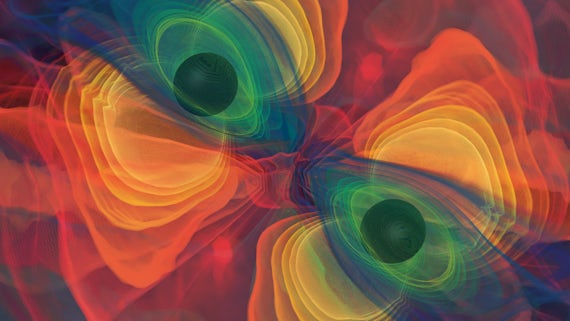Gamma ray-bursts
Mae'r cynnwys hwn ar gael yn Saesneg yn unig.
Our researchers are leading the search for gravitational waves from gamma-ray bursts, which are among the most electromagnetically luminous phenomena in the universe.
Gamma-ray bursts
Gamma-ray bursts can release as much energy in a few seconds (1051 erg) as our sun will emit during its entire 10 billion-year lifetime. Observational evidence indicates that there are two distinct types of gamma-ray bursts, produced by different — but both extremely violent — events in the universe.
Short gamma-ray bursts last less than two seconds, and are thought to be produced by the collision and merger of a pair of neutron stars, or a neutron star with a black hole. These will orbit one another and gradually lose energy in the form of gravitational waves, making their orbits shrink before eventually causing a collision. This produces a distinctive "chirp" signal that can be detected by Advanced Laser Interferometer Gravitational Wave Observatory (LIGO) and Advanced Virgo detectors from hundreds of light years away.
Long gamma-ray bursts last longer than two seconds, and are believed to result from collapsars, the collapse of the core of a massive star down to form a black hole, or perhaps a short-lived magnetar. Either scenario can produce a large burst of gravitational waves through various mechanisms, such as instabilities in the disk of matter falling onto the central black hole.
Detecting gravitational waves
The detection of gravitational waves will allow us to probe the physics at the hearts of these gamma-ray bursts. It would provide 'smoking gun' proof that short gamma-ray bursts are due to binary mergers, and may resolve the collapsar/magnetar question surrounding long gamma-ray bursts.
We have developed cutting-edge techniques to sift LIGO and Virgo data for both binary merger signals and generic bursts of unknown shape. This work has led to a number of results by LIGO and Virgo limiting gravitational wave emission by gamma-ray bursts as well gravitational waves associated with other phenomena such as high-energy neutrino candidates.
Currently we are searching for gravitational waves with Advanced LIGO and Advanced Virgo. We operate automated analyses that can run within minutes of a gamma-ray bursts, with alerts released quickly to the astronomy community.
Given the challenges of localising gravitational wave sources with the Advanced LIGO - Advanced Virgo network, there is every chance that a gamma-ray burst will be the first source observed simultaneously in gravitational waves and electromagnetic radiation — a tremendously exciting prospect!
Related publications
- Clark, J. et al. 2015. Prospects for joint gravitational wave and short gamma-ray burst observations. Astrophysical Journal 809 (1) 53. (10.1088/0004-637X/809/1/53)
- Williamson, A. R. et al. 2014. Improved methods for detecting gravitational waves associated with short gamma-ray bursts. Physical Review D - Particles, Fields, Gravitation and Cosmology 90 (12), pp.-. 122004. (10.1103/PhysRevD.90.122004)
- Aasi, J. et al., 2014. Search for gravitational waves associated with gamma-ray bursts detected by the interplanetary network. Physical Review Letters 113 (1) 11102. (10.1103/PhysRevLett.113.011102)
- Adrián-Martínez, S. et al., 2013. A first search for coincident gravitational waves and high energy neutrinos using LIGO, Virgo and ANTARES data from 2007. Journal of Cosmology and Astroparticle Physics 2013 (6) 8. (10.1088/1475-7516/2013/06/008)
- Was, M. et al., 2012. Performance of an externally triggered gravitational-wave burst search. Physical Review D 86 (2) 22003. (10.1103/PhysRevD.86.022003)
- Abadie, J. et al., 2012. All-sky search for gravitational-wave bursts in the second joint LIGO-Virgo run. Physical Review D Particles and Fields 85 (12) 122007. (10.1103/PhysRevD.85.122007)
- Abadie, J. et al., 2012. Search for gravitational waves associated with gamma-ray bursts during LIGO science run 6 and Virgo science runs 2 and 3. Astrophysical Journal 760 (1) 12. (10.1088/0004-637X/760/1/12)
- Abadie, J. et al., 2012. Implications for the origin of GRB 051103 from LIGO observations. Astrophysical Journal 755 (1) 2. (10.1088/0004-637X/755/1/2)
- Harry, I. W. and Fairhurst, S. 2011. A coherent triggered search for single-spin compact binary coalescences in gravitational wave data. Classical and Quantum Gravity 28 (13) 134008. (10.1088/0264-9381/28/13/134008)
- Harry, I. W. and Fairhurst, S. 2011. Targeted coherent search for gravitational waves from compact binary coalescences. Physical Review D 83 (8) 84002. (10.1103/PhysRevD.83.084002)
- Sutton, P. J. et al. 2010. X-Pipeline: an analysis package for autonomous gravitational-wave burst searches. New Journal of Physics 12 53034. (10.1088/1367-2630/12/5/053034)
LIGO scientists detect gravitational wave signal from the merging of two black holes.


